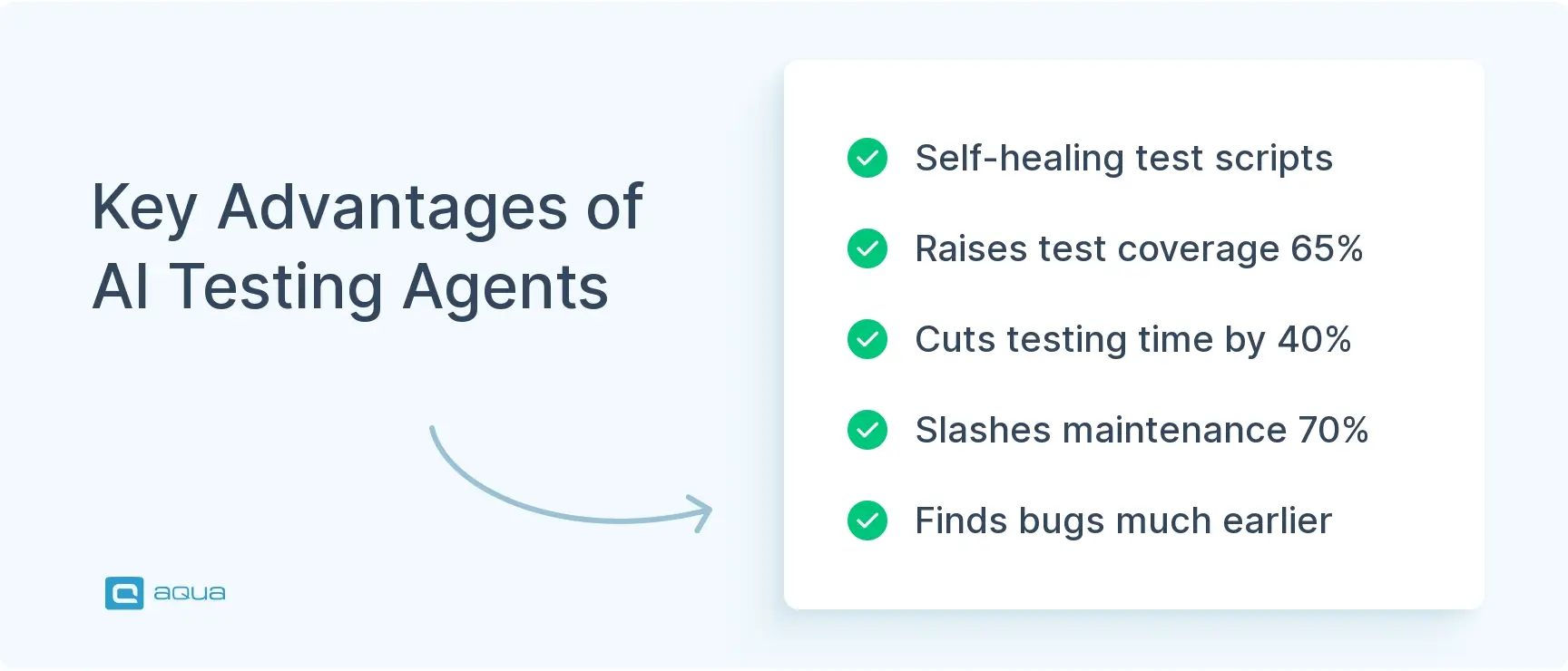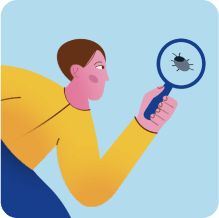Key Takeaways
- AI testing agents use machine learning, computer vision, and natural language processing to autonomously test software applications without constant human intervention or script maintenance.
- Unlike traditional test automation that breaks when interfaces change, AI agents can adapt to UI modifications by recognizing elements through visual patterns and contextual understanding.
- Organizations implementing AI testing report up to 65% increased test coverage, 40% reduced testing time, and 70% less maintenance effort compared to traditional testing frameworks.
- AI agents excel at autonomous exploratory testing, visual validation, performance monitoring, and test prioritization based on risk assessment and historical defect patterns.
- Successful implementation requires starting with specific pain points, gradually scaling up, integrating with CI/CD pipelines, and maintaining human oversight for complex evaluations.
Testing teams face a significant maintenance burden with traditional automation scripts. Could AI agents that self-heal and adapt to application changes be the solution you need? Learn how they work and where they deliver the most value 👇
What Are AI Testing Agents?
AI testing agents are digital teammates that test software the way people do, only faster. Old automation tools just replay scripts. They work as long as nothing changes. Once a button moves or a page looks different, the tests break. AI agents for software testing don’t stop there. They look at the app, make sense of it, and decide what to do next.
Think of AI agents testing as coworkers who handle the repetitive parts of QA. They explore, notice changes, and keep running without constant fixes. This is why teams see them as partners in the testing process.
Here’s what makes AI agents in software testing different:
- They act on their own
No need to start every run by hand. - They adjust when apps change
Layouts shift, menus move: tests still pass. - They understand context
A button is seen by purpose, not just by code. - They design useful tests
Agents create tests from real user flows and risky areas. - They learn from each run
Over time, they focus more on where bugs appear.
This is the value of tools for AI-based test automation. Traditional tools only follow orders. AI testing agents bring flexibility, awareness, and speed, closer to how people test, but with the reach of automation.
How Do AI Agents Work? Understanding Their Functionality
Now that we know what AI testing agents are, the next step is to see how they actually work. Unlike scripted tools that simply repeat instructions, AI agents for software testing follow a cycle of observing, analyzing, acting, and learning. This loop makes them flexible and able to keep pace with fast-changing applications.
It begins with perception. The agent observes the app, scanning the interface, reading the DOM, or using computer vision to understand what’s on the screen. Instead of just looking for a field called username, it recognizes a text box next to the word email as a login input.
Next comes analysis. The agent builds an internal map of the application; its screens, workflows, and expected outcomes. Over time, this understanding gets sharper. For example, it learns that submitting a form should either trigger a confirmation message or an error if details are missing.
Then comes action. Based on what it knows, the agent interacts with the app. It clicks buttons, fills forms, and navigates pages. Unlike traditional automation, it doesn’t have to follow the same rigid path every time. It can try variations and explore different user journeys.
Finally, there is learning. After running actions, the agent checks whether the app behaved as expected. If not, it adjusts. Each run teaches it more, allowing it to focus testing effort on the areas most likely to break.
Let’s make this concrete with a simple example. Imagine testing the checkout flow of an online store. A scripted test would always add the same product, go through checkout with the same steps, and use the same payment details. If the purchase button changed from Complete Purchase to Place Order, the test would fail. An AI agent handles it differently. It would:
- Observe the checkout page and recognize it visually, not just by code
- Identify the fields and buttons, even if they’ve been renamed or moved
- Fill in realistic details like card numbers or addresses
- Adapt if a new step appears in the checkout process
- Learn from the results and refine its approach for the future
This is the difference that makes AI agents in software testing so valuable. Instead of collapsing when the app shifts, they adapt, explore, and improve.
As we explore the transformative potential of AI agents in software testing, it’s worth considering how these technologies are being integrated into comprehensive testing platforms. While autonomous AI agents represent the future of testing, the reality is that most organizations need a practical bridge between traditional testing approaches and advanced AI capabilities, a solution that brings intelligence to their existing workflows without requiring a complete overhaul.
This is where aqua cloud’s AI-powered test management platform excels. While AI testing agents work to explore and validate your applications, aqua provides the central nervous system that coordinates, manages, and enhances your entire testing ecosystem. Its AI Copilot can generate comprehensive test cases directly from requirements in seconds, with 42% requiring no edits whatsoever. By integrating both manual and automated testing in a single repository, aqua ensures complete traceability while allowing teams to execute tests through popular frameworks like Selenium, Playwright, and Cypress, alongside popular integrations like Jira, Confluence, Azure DevOps. Organizations implementing aqua report saving an average of 12 hours per tester each week, with up to 60% faster time-to-market for digital applications. The platform’s ability to adapt to changes through reusable components and AI-assisted maintenance aligns perfectly with the adaptability needs highlighted in this article.
Transform your testing approach with AI that works alongside your team, not just as an autonomous agent
Comparing AI Agents with Automated Workflows
To see the real value of AI testing agents, it helps to compare them with traditional automation. Both aim to make QA faster and more reliable. But their strengths and limits are very different.
Traditional test automation is script-driven. Tools like Selenium or Cypress follow exact steps: click here, type there, expect this result. These scripts work well until the app changes. A small update, like a renamed button, can break dozens of tests.
AI agents in software testing take another route. Instead of relying only on fixed paths, they use AI to recognize screens, understand context, and adapt when something changes. They don’t just replay instructions: they explore, decide, and improve with each run.
Here’s how the two approaches compare:
| Aspect | Traditional Test Automation | AI Testing Agents |
|---|---|---|
| Creation | QA engineers write and maintain scripts | Agents generate tests from app analysis and past results |
| Adaptability | Breaks when UI or workflows change | Adjusts by recognizing elements visually and contextually |
| Maintenance | High—scripts need constant updates | Lower—self-healing reduces manual work |
| Decision Making | Follows fixed paths | Chooses what to test based on risk and learning |
| Coverage | Limited to scripted cases | Can uncover unexpected scenarios |
| Setup | Straightforward but requires coding skills | Needs initial training and setup |
| Best Use | Regression testing of stable features | Dynamic apps with frequent changes, large-scale exploration |
| Scalability | More tests require more scripts | Improves and scales as the agent learns |
| Insights | Pass/fail only | Deeper insights into risks and patterns |
So when should you use each approach?
Traditional automation is still a good fit for:
- Stable features that rarely change
- Compliance tests where every step must be documented
- Simple applications with predictable flows
The best AI agents for software testing stand out in:
- Apps that change often and break scripts
- Complex products with many user paths
- Large-scale exploratory testing
- Teams with limited resources for test maintenance
In practice, most teams end up with a mix. They keep traditional automation for stable, business-critical flows and use AI agents testing where change is constant and coverage is hard to achieve. This hybrid model gives them reliability where it matters most and flexibility where it’s needed most.
Practical Applications of AI Agents in Software Testing
AI agents in software testing aren’t just ideas on paper. They’re already being used in real projects to tackle problems that slow QA teams down. Here’s where they’re making the biggest impact:
Test Case Generation and Maintenance
Building and maintaining test suites has always been heavy work. AI testing agents cut that burden by generating tests automatically from code, requirements, and user behavior. They also keep tests alive when apps change, updating cases instead of letting them break. This “self-healing” ability is a huge win in agile teams where the UI shifts weekly.
Autonomous Exploratory Testing
Exploratory testing is powerful but limited by time and human imagination. AI agents can run this continuously. They try new paths, vary inputs, and explore edge cases that manual testers might not think of. The result: hidden bugs surface earlier, before they slip into production.
Visual Testing and UI Validation
Visual issues are some of the hardest to catch with scripts. AI agents use computer vision to scan screens across devices and browsers, spotting problems like overlapping text, broken layouts, or missing elements. Unlike pixel-matching tools, they understand context and know the difference between a real issue and a harmless variation.
Performance and Load Testing
Instead of replaying static load scripts, AI agents simulate traffic that looks and feels real. They adjust test parameters on the fly, analyze response times, and detect bottlenecks before users feel them. This makes performance testing smarter, not just bigger.
Test Prioritization and Risk-Based Testing
Not all features carry equal risk. AI agents help QA teams decide what to test first by analyzing code changes, complexity, and past defect history. This ensures the riskiest areas get the most attention, reducing the chances of critical bugs reaching production.
End-to-End Testing Automation
End-to-end tests often break because one small step changes. AI agents make these journeys resilient. They recognize the overall workflow like checkout, registration, or onboarding, and adapt even if buttons move or forms change. That means less maintenance and more reliable coverage.
These practical AI applications in testing show why AI testing agents are gaining traction. They help teams adapt, uncover more issues, and deliver higher-quality software with less effort.
The Benefits and Challenges of Adopting AI Testing Agents
Bringing AI agents into your testing process can feel like a big step. The rewards are clear, but there are also hurdles you’ll need to prepare for. Understanding both sides helps you decide if these tools fit your workflow right now.
Benefits of AI Testing Agents
Greater coverage and efficiency
AI testing agents can cover far more ground than scripts. They run continuously, work in parallel, and adapt to different environments without slowing down. This means fewer blind spots and more bugs caught before release. If you’re looking for the best AI agents for software testing, the real value is in how much time and effort they save compared to fixing and maintaining brittle scripts.
Less maintenance work
You know the pain of broken tests after every UI change. AI agents take most of that burden off your shoulders. They adjust to new layouts or workflows automatically, so you spend less time patching old tests and more time designing new ones.
Finding bugs earlier
Catching issues late in the cycle is expensive. Because AI agents keep testing and learning in the background, they spot risks sooner. Instead of reacting after a failure, you get proactive alerts when something looks off, giving you a head start on fixes.
Faster releases without sacrificing quality
If you’re working in agile or DevOps, speed matters. AI agents remove the bottleneck of repetitive checks and feed fast feedback into your pipeline. That’s how leading AI agents in software testing help teams shift from slow, monthly releases to weekly or even daily drops, without letting critical bugs slip through.

Challenges of Adopting AI Testing Agents
Data requirements
AI needs good data to perform well. If your app is new or you don’t have much history, results will be limited. The way around this is to create synthetic data, reuse logs, or start small with core workflows so the agent has something to learn from.
Integration into your process
Plugging AI agents into your CI/CD setup often means rethinking parts of your workflow. Legacy systems can make this tricky. The smoother path is to start with a small integration, maybe a non-critical flow: prove the results, and then expand once it’s stable.
Trust and transparency
AI can feel like a black box. You might wonder why it flagged a bug you didn’t see or why it chose a certain path. To avoid this, pick tools for testing AI agents that give you explainable results and clear reports. That way, you can actually trust what the agent is doing.
Skill and training gaps
Working with AI agents isn’t the same as writing Selenium scripts. You’ll need to learn how to guide them and interpret results. The easiest way to close this gap is by training your QA team step by step and introducing AI-driven tasks alongside your current tests.
Costs and ROI
The best AI agents for software testing do pay off, but not instantly. You’ll face upfront costs for licensing, setup, tokens usage and training. A smart move is to run a pilot project, measure the time saved, and use that data to build your case for scaling up.
AI agents in software testing give you speed, resilience, and smarter insights than traditional automation. They also ask for better data, new skills, and some upfront investment. If you start small, pick the right tools, and prepare your team for the change, you can turn AI agents software testing automation into one of your biggest advantages.
Best Practices for Effectively Using AI Testing Agents
Bringing AI agents into your workflow isn’t only about picking the right tool. To get real value, you need to integrate them carefully and give them the right conditions to succeed. Here are some best practices that will help you get there:
Start with clear problems
Before rolling out AI agents in software testing, ask yourself what hurts the most today. Do broken scripts eat up your time? Are you missing coverage in critical flows? Is execution slowing down releases? Focus your agents on these pain points first. Solving one clear problem builds trust in the approach and gives you quick wins.
Begin small and expand
Don’t try to automate everything at once. Pick a single feature, module, or test type as a pilot. Define what success looks like, measure it, and then scale gradually. This controlled rollout lets you learn without disrupting your whole QA process.
Integrate with test management and CI/CD
AI testing agents are most powerful when they’re part of the pipeline. Integrating AI with test management starts with connecting them to your CI/CD system so they run automatically with every code change. Link results directly to your test management platform to keep visibility high. This makes AI testing a natural part of development rather than a side activity.
Combine AI with human strengths
AI agents testing tools are great for repetitive regression checks and broad coverage, but they don’t replace human judgment. Let agents handle routine work, while testers focus on exploratory testing, user experience, and investigating tricky defects. The best results come when humans and AI support each other.
Use good, representative test data
AI agents learn from the data you feed them. If that data is incomplete, biased, or unrealistic, your results will suffer. Invest in clean, diverse test data that mirrors real user behavior. Where production data can’t be used, create synthetic sets that still reflect real-world patterns.
Track results and adjust
Measure the impact of AI with clear metrics: defect detection rate, false positives, test coverage, and time saved on maintenance. Review these numbers regularly. If you see gaps, adjust how you’re using the agents. Leading AI agents in software testing will improve as you tune them.
Keep humans in the feedback loop
AI agents improve fastest when testers guide them. Create a simple way for your team to mark AI findings as valid, invalid, or uncertain. Feeding this back into the system helps refine models and reduces noise over time.
If you follow these practices, you’ll get the most out of AI agents software testing automation. It’s about using the best AI agents for testing where they shine, while letting your testers focus on the work that only people can do.
Tips for Using AI Testing Agents Effectively
You’ve seen the best practices for getting started. Now let’s zoom in on some practical tips that will help you get the most out of AI testing agents day to day. These are the habits that keep your setup reliable, your results trustworthy, and your QA team focused on what matters most.
- Prioritize data quality
Clean, diverse test data gives far better results than large volumes of noisy or incomplete data. - Set clear expectations
Make sure stakeholders understand what AI testing agents can do well and where human testers are still essential. This avoids resistance and disappointment. - Adopt a hybrid approach
Use AI agents in testing where they shine: exploration, adaptation, scale. Keep traditional automation for stable, compliance-heavy flows. - Document your processes
Record data sources, model choices, and decision criteria. This builds transparency and makes it easier to onboard new testers. - Build new skills
Invest in training your team to work effectively with AI testing agents. If needed, bring in specialists or partner with experts until your team is confident. - Tune alerts and notifications
Configure meaningful signals so major issues get quick attention without drowning in minor noise. - Keep coverage evolving
Regularly review where your AI agents are focusing. Update their scope as your app grows and new risks appear. - Make results visible
Use dashboards and visualization tools to show AI testing results clearly. This makes it easier for developers to act on findings. - Test the testers
Consider using tools for testing AI agents themselves. This ensures they continue functioning as expected and provide reliable results. - Look for proven leaders
Explore whether the leading AI agents in software testing are a good match for your industry and application type. Check benchmarks and case studies from companies similar to yours.
As we’ve explored throughout this article, AI agents are changing software testing by bringing intelligence, adaptability, and autonomy to quality assurance processes. However, successfully implementing these advanced capabilities requires more than just the agents themselves, it demands a cohesive platform that integrates AI throughout the entire testing lifecycle.
aqua cloud stands as the comprehensive solution that bridges this gap, combining powerful AI capabilities with enterprise-grade test management. With aqua’s AI Copilot, you can generate test cases from requirements in seconds, instantly create documentation, and maintain complete traceability from conception to execution. The platform unifies manual and automated testing in a single repository, integrates seamlessly with tools like Jira and Jenkins, and provides real-time dashboards that make quality visible to all stakeholders. Organizations using aqua report dramatic efficiency gains: saving over 12 hours per tester weekly and reducing time-to-market by up to 60%. The platform’s flexibility in supporting both traditional scripts and AI-driven approaches makes it ideal for teams transitioning to more intelligent testing methodologies. As testing continues to evolve toward greater automation and intelligence, aqua provides the foundation that empowers your team to embrace these innovations without sacrificing control or visibility.
Experience the perfect balance of human expertise and AI-powered efficiency with aqua cloud
Conclusion
AI agents for software testing make it possible to keep testing fast, flexible, and reliable in modern development. They go beyond scripts by adapting to changes, learning from results, and covering more ground with less effort. The practical AI applications in testing already include test generation, exploratory testing, visual checks, performance monitoring, and risk-based prioritization. Adopting them still means tackling challenges like data, integration, and new skills. But, when combined with human judgment they deliver faster releases, stronger coverage, and higher-quality software. For QA teams looking ahead, this balance between people and AI is the key to staying efficient and effective.

















